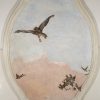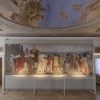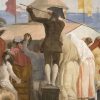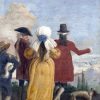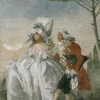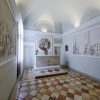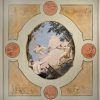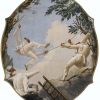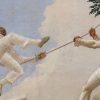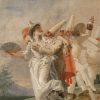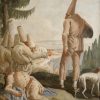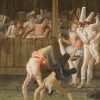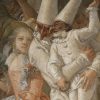In these rooms you can admire the fresoces painted by Giandomenico Tiepolo in the family villa in Zianigo. Stripped in 1906 for sale abroad, they were purchased by the town of Venice and transferred in 1936 to Ca’Rezzonico. Here they were hung in small rooms which wherever possible reproduce their original location. The paintings were completed over a fairly long period, between 1759 and 1797, and undoubtedly constitute one of the most fascinating, singular bodies of work in the whole of Venetian painting. They are works painted not for a client but for the artist and his family’s own pleasure, in the private context of their home. This very circumstance freed the painter from thematic and figurative conventions and allowed him to follow his own intimate nature, a propensity to sarcastic description of the world around him.
The first work in front of the door shows a scene from Torquato Tasso’s poem Jerusalem Delivered. It shows Rinaldo Abandoning the Garden of Armida, and was formerly on the ground floor of the villa of Zianigo. We are still in a figurative dimension, where both style and theme are closely linked to Giandomenico’s father’s world. The subject is connected to the grand Baroque tradition of historical painting; Giandomenico however interprets it with an ungrammatical expressiveness which corrodes its solemn, sophisticated effect. His particular nature is fully expressed on the left of the back wall, in the snapshot-like image of the Hawk Swooping onto the Flock of Sparrows in Flight. This was originally a ceiling and, instead of his father’s mythologies, Giandomenico painted a theme of limpid, natural simplicity. It is impossible not to see in this painting an allusion to the empirical culture of the Enlightenment, where the sky is the space of birds and not the home of ancient divinities.
The frescoes in the next room repropose themes already painted by Giandomenico Tiepolo in his youth in the guest quarters of the villa Valmarana. After many years he gave them a new monumental form and reinterpreted them with a more mature eye which scrutinised his contemporaries with ruthless irony. The New World shows a crowd of people thronging around the huckster in his booth with the magic lantern, called in fact “New World” for the images of exotic places shown inside it. This amusement attracted not only children as was traditional, but the whole of society: common people, peasants, the middle classes; here they are all depicted lifesize from the rear in a single great anti-portrait. In this fresco, Giandomenico overturns the classic conception of representation; the scene does not present itself to the viewer but paradoxically denies itself to our scrutiny, hiding that very show which had drawn the crowd. We are not looking at a scene, rather at someone who in turn is watching what is happening. In the two minor scenes, the painter presents another theme which is particularly dear to him, that of the promenade and the dance. Here they lose that chivalrous, fashionable context typical of Giandomenico’s early small pictures. The Promenade in the villa conveys an involuntarily comic effect: the sophisticated elegance of the clothes strikes a false note when they are seen on the skinny, scraggy limbs of personages who again turn their backs on us, making a stage exit.
The frescoes decorating the small chapel were probably the first ones painted in the villa by Giandomenico Tiepolo. The chapel was in fact dedicated in 1758 to the blessed Jerome Miani, the founder of the order of the Somaschi to which the painter’s younger brother, Giuseppe Maria, belonged. Besides the altarpiece with the Madonna and Child adored by St. Jerome Miani and St. James the Apostle, Giandomenico painted two monochromes of the saint’s life at either side. Following his propensity for concreteness and close observation of reality, Giandomenico interpreted the two miraculous events as moments in the life of a seminary, a life veiled with melancholic squalor, spare and frugal, where there is no space for miracles.
The Punchinello (or Punch) Room, which is actually a proper bed-chamber, was the last one to be painted by Giandomenico Tiepolo, and it is perhaps the most famous of the whole cycle. In contrast with the show which is denied to the viewer in the New World, a swarming multitude of figures is offered up to us here. The main character is Punchinello, the Commedia dell’Arte character who embodies the popular soul in an eternal parody of Man and his weaknesses. In the last years of his life, Giandomenico was literally obsessed by this figure, whom he painted on the walls of his house and in dozens of drawings which were then collected in an album. This album has since been dismantled and its single sheets have been scattered over various public and private collections.
In this Commedia dell’Arte character the artist found the perfect incarnation of that irreverent, sarcastic spirit which was his own natural disposition. In the frescoes in this room, innumerable Punchinellos have suddenly emerged from the entrails of the earth up a ladder. They perform the same actions as the nobility, or mimic the protagonists of the fairytales and mythologies described by Giambattista Tiepolo. They have fun on the swing, flirt with the women during carnival, watch the tumblers’ shows, carouse and get drunk, join the promenade; in one of the monochromes they even chase away a fashionably-dressed young lady.
The future imagined by the painter is tragic-comic, terrifying and topical in its pessimism. He contrasts the fatuous New World with another brand-new world, a world populated with irreverent, rough people, a world of free, equal individuals. Here Giandomenico appears to allude to the revolutionary message then arriving from France. It may be a coincidence, but the date of the completion of the frescoes was 1797, the fatal year of the fall of the Venetian Republic.


